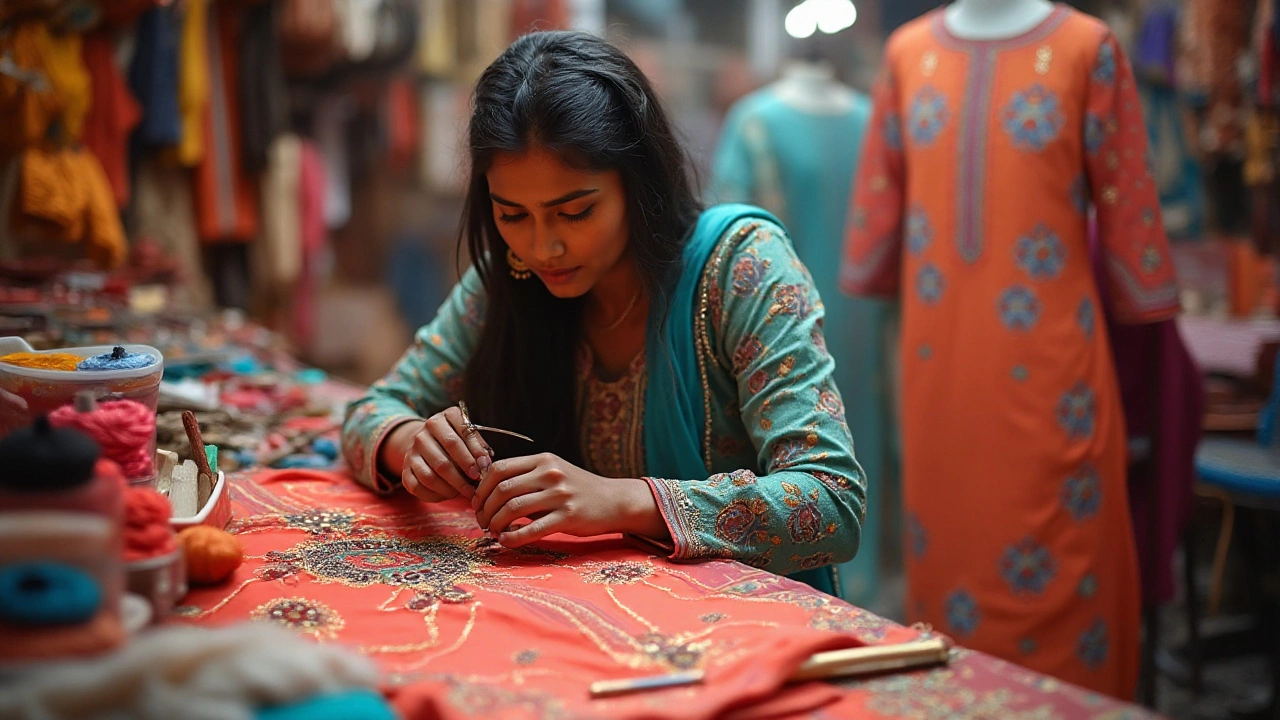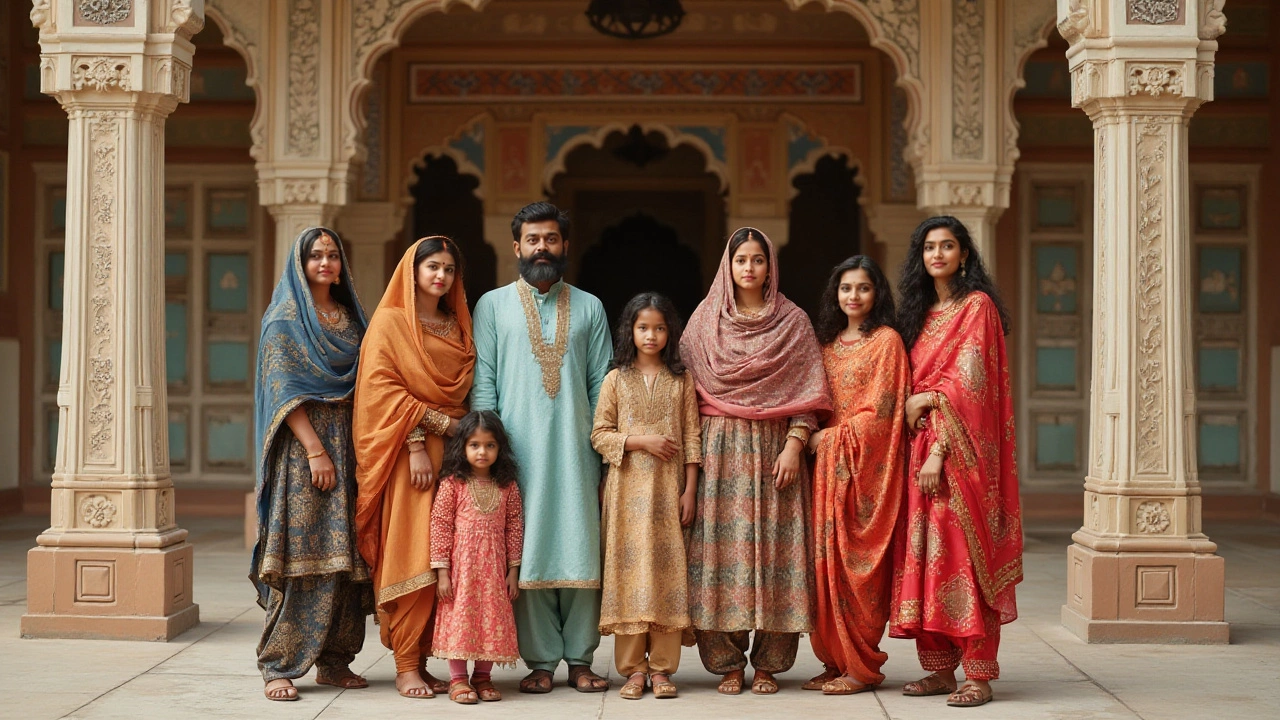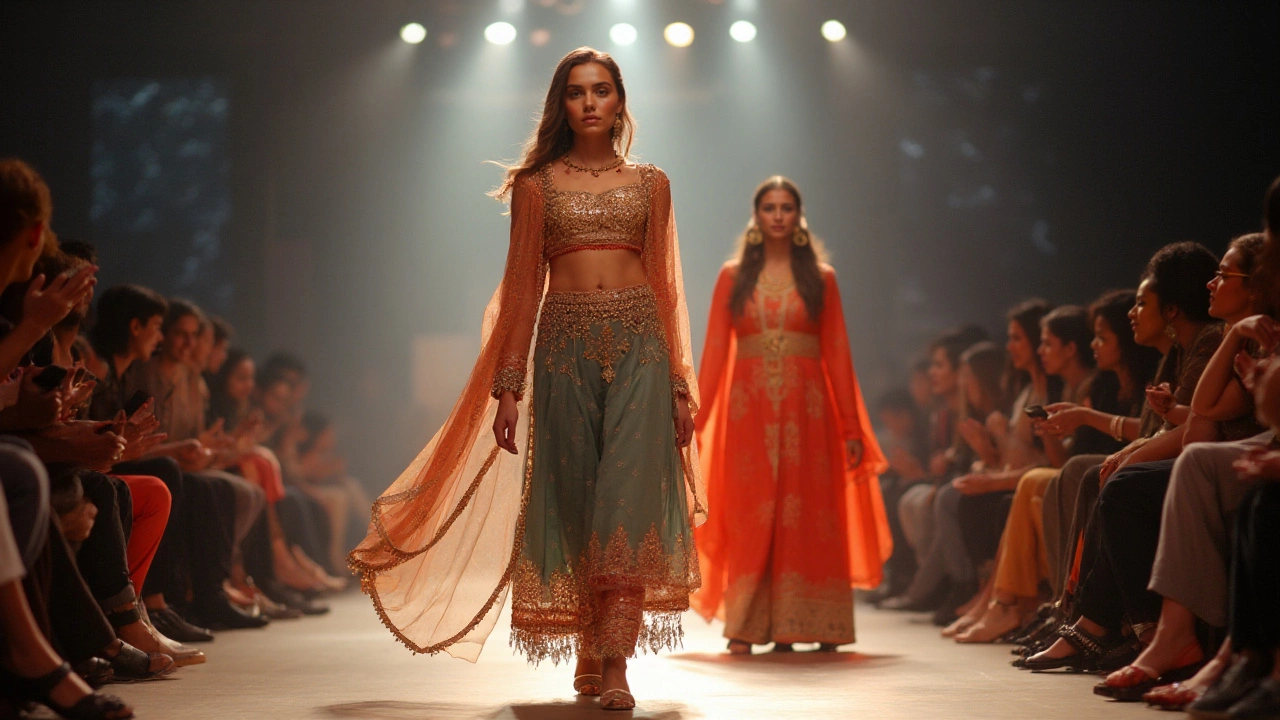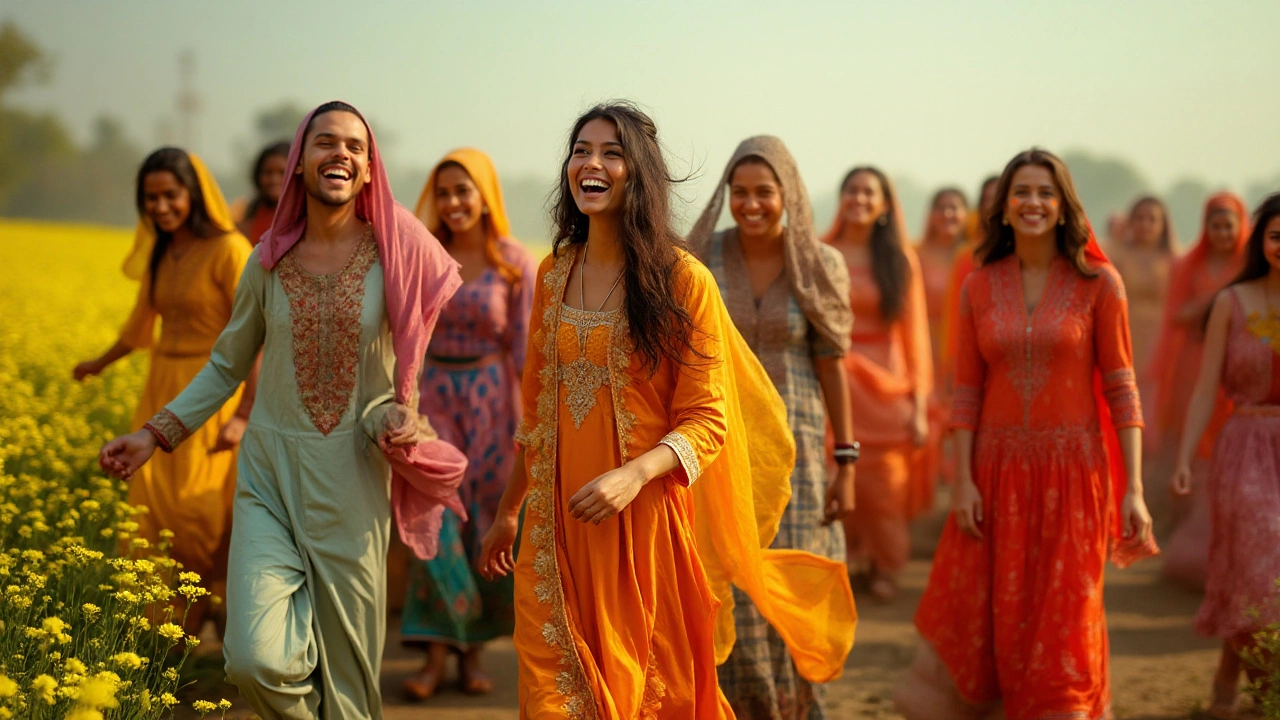When one thinks of Punjabi attire, vibrant colors, striking patterns, and a legacy of culture come to mind. Rooted in the heartland of Punjab, this traditional clothing isn't just fabric and seams but a beautiful testimony to the region's rich history and the artistry of its people.
The traditional attire for Punjabi women is the Salwar Kameez, often accompanied by a colorful Dupatta. This combination offers both comfort and elegance, allowing for freedom of movement while maintaining a sense of style. Men's traditional dress, on the other hand, is typically the Kurta Pajama paired with Punjabi Jutti, merging simplicity with cultural pride.
What makes Punjabi clothing stand out are the intricate embroidery and vibrant hues that echo the zestful spirit of Punjab. Over the years, designers have reimagined these traditional forms into contemporary interpretations, making them popular choices far beyond the geographical boundaries of Punjab.
Traditional Women's Attire
In the realm of Punjabi dress, the Salwar Kameez stands as a celebrated icon of comfort and elegance. This timeless attire consists of three main components: the Kameez (tunic), the Salwar (trousers), and the Dupatta (scarf). The Kameez is typically knee-length or even longer, with variations in sleeve length, depending on contemporary trends or personal preference. The Salwar, known for its loose-fitting nature, ensures ease of movement, making it a practical choice in both rural and urban settings. This attire is complemented by the Dupatta, often colorful and elaborately embroidered, adding a touch of grace and modesty.
The beauty of the Salwar Kameez lies in its adaptability. Women often choose fabrics and designs that best suit the occasion, with a plethora of options ranging from rich silks for festive events to light cotton for everyday wear. Embroidery, mirror work, and bead embellishments are common, transforming a simple outfit into an exquisite ensemble. The array of vibrant colors is reflective of the lively spirit and culture of Punjab, where fashion and festival seamlessly blend.
Indian fashion designers have frequently drawn inspiration from the traditional Salwar Kameez, propelling it onto international runways. This traditional clothing serves as a canvas for innovative designs while keeping the cultural essence intact. In the words of renowned fashion designer Ritu Kumar,
"Punjabi attire celebrates the colors of life, allowing a deep connect between tradition and modernity."Such endorsements only emphasize the garment's universal appeal.
Interestingly, the Salwar Kameez has evolved over time and travels through different regions of India and beyond. Its design has seen influences from Persian and Afghan styles, which adds layers of history and depth to its narrative. The versatility of the Salwar Kameez is not just limited to its design, but extends to its social significance as well, often worn during life’s most important ceremonies or simply as daily wear. This attire is every bit a story, a tradition stitched into each thread.
When it comes to accessorizing the Salwar Kameez, Punjabi women opt for traditional jewelry to enhance the ensemble. Jhumka earrings, Maang Tikka for the forehead, and bangles made of glass or metal are commonly paired with this attire. The entire look resonates with a sense of celebration and cultural pride. For footwear, nothing beats the traditional Punjabi Jutti, an embroidered leather shoe that completes the entire attire. Often, the combination of these elements not only makes a fashion statement but also speaks profoundly of a rich cultural history.
A final note on this fascinating garment is its growing appreciation around the world. Cultural events, international schools, and fashion shows have embraced the Salwar Kameez, acknowledging its elegant simplicity and profound beauty. Many non-South Asians prefer the Salwar Kameez for its comfort and style, often opting for this Punjabi attire as an elegant choice for both formal and casual occasions. This cross-cultural admiration reflects a growing interest in traditional Indian motifs and aesthetics, placing the Salwar Kameez as a staple in global fashion narratives.

Traditional Men's Attire
When you picture a traditional Punjabi man's outfit, your mind likely conjures vibrant images of the classic Kurta Pajama. This outfit, with its roots deeply embedded in the cultural fabric of Punjab, reflects the simplicity and grace of the men who donned it for centuries. A kurta is a long, loose-fitting shirt that extends to the knees or just below, and it's usually accompanied by pajamas, which are loose trousers that taper down at the ankles. Crafted from materials like cotton, silk, or linen, the Punjabi dress for men prioritizes comfort while exhibiting a certain level of sophistication. Each kurta can sport a range of designs from plain, solid colors to intricate embroidery, showcasing the wearer's personality and a hint of regional artistry.
The Kurta Pajama isn't just about comfort; it stands as a beacon of cultural heritage that spans beyond religious and regional boundaries within India. Men from all walks of life choose this iconic attire for events ranging from informal gatherings to grand festivities. Some designs feature chikankari or phulkari embroidery, adding an artistic layer to the ensemble that pays homage to the realm of Punjab. In addition to household and casual wear, the kurta pajama is jazzed up with embellishments and chosen for festivals and weddings, signifying the poignant role it plays in ceremonies. In recent times, this traditional craft has found a global audience, echoing a sentiment of nostalgia and admiration for ancient fashion philosophies.
There's also the Achkan, or Sherwani, a more formal counterpart of the kurta pajama typically worn during weddings or special occasions. The Achkan, similar to a knee-length jacket, is often richly adorned with embroidery and paired with a turban to complete the look. This epitomizes the royal elegance associated with traditional Punjabi attire, keeping the past alive by weaving in the threads of modernity and luxury. Often woven with silk or brocade, the ensemble has become synonymous with Punjabi grooms who seek both tradition and splendor at their weddings. Navdeep Gill, a renowned designer, once noted,
"A well-crafted Sherwani doesn’t just dress the body but adorns the soul, capturing the essence of Punjab's timeless elegance."
Not to be overlooked is the quintessential Punjabi Jutti. These traditional leather footwear pieces are not only known for their comfort but also for their elaborate craftsmanship that often features rich embroidery and embellishments. Seen as the perfect finishing touch to any traditional Punjabi outfit, the Jutti comes in a myriad of designs and colors, each telling its own story. Though the style remains largely unchanged over generations, adaptations with modern designs and materials have emerged, widening the appeal. They provide a vivid glimpse into the craftsman’s skill passed down through generations, maintaining Punjabi culture’s vibrancy with every stitch and embellishment.
In contemporary fashion runways, traditional Punjabi men's attire has experienced metamorphosis, with designers experimenting with silhouettes, fabrics, and accessories, balancing tradition and modernity. This evolution symbolizes a fascinating dialogue between an enduring cultural legacy and an ever-changing fashion landscape. Through fusion styles, the timeless appeal of Punjabi men's clothing resonates not only within India but around the world, championing a quintessential cultural narrative woven through threads of modernization and innovation.

Cultural Significance
The significance of traditional Punjabi dress goes far beyond the cloth and patterns that make up each piece. It embodies the essence of Punjabi culture and its historical depth. From ancient times, these garments have been a symbol of societal roles and local traditions. Every thread and stitch tells a story passed down through generations, signifying personal and communal milestones like festivals, weddings, and the joyous harvest celebration of Baisakhi.
Throughout the ages, the vibrant colors and designs of Punjabi attire have expressed more than taste—they have communicated identity and status. For instance, specific patterns and embroidery styles can denote different Punjabi communities and regions. During festivals like Lohri and Holi, one can witness a rainbow of traditional clothing that keeps these age-old customs alive. Not only are they markers of identity, but they also serve the practical purpose of comfort in the varying climates of Punjab, from the crisp mornings of spring to the sultry summers.
The social settings where these dresses are worn also reveal a deep cultural narrative. In the grand Punjabi weddings, the Lehengas, Kurta Pajamas, and Sherwanis take center stage, presenting a blend of cultural continuity with modern flair. These occasions showcase the elaborate art of Punjabi embroidery, known for its beadwork and the exquisite Phulkari, a traditional folk embroidery. Nobel laureate Rabindranath Tagore once praised the richness of Punjabi culture, highlighting its 'bright, bold, and beautiful' expressions of life and community through clothing.
Panjab is less a state, more a continual celebration. Through their clothes, they embody a constant festival, a way of being.Such quotes underscore the symbolic resonance held within each attire piece.
The Global Influence
Interestingly, as Indian diasporas spread across the globe, the love for Punjabi attire has similarly transcended borders. Many cultural festivals in places like Canada, the United States, and the UK see second and third-generation Indians showcasing their roots through Salwar Kameez and Kurta Pajamas. As fashion movements turn increasingly multicultural, these traditional garments, with their unique and expressive designs, have become a source of inspiration for mainstream fashion designers, encouraging an appreciation for world cultures.
Soon, these colorful fabrics that were once confined to the plains and fields of Punjab became symbols of ethnic pride worldwide, seen at international runways and cultural fairs. Their ongoing appeal lies in their unique capacity to weave together tradition, comfort, and style. Through a modern lens, Punjabi attire speaks of resilience and adaptation, all while remaining rooted in its essence. Embracing these clothes connects individuals not only to their ancestry but also to a broader tapestry of humanity’s shared living culture.

Modern Adaptations
Punjabi attire has beautifully evolved over time, taking traditional aesthetics and reimagining them to fit into contemporary fashion landscapes. This evolution is not just a trend but a fascinating transformation led by designers who admire the depth and vibrancy of Punjabi culture. Modern adaptations of Punjabi dress elegantly integrate the rich heritage of original styles with the sensibilities of today's fashion-forward world. By balancing tradition and modernity, these adaptations bring the cultural richness of Punjab to a global audience, creating a diverse yet connected fashion narrative. Designers often use various fabrics, textures, and colors, experimenting with layers and silhouettes to create something fresh and unique. They infuse the attire with contemporary cuts while maintaining the essence of traditional clothing techniques.
The influence of Punjabi attire on modern fashion is hard to overlook. For instance, the Salwar Kameez, once purely traditional, is now seen in various western styles, sometimes even embracing cuts and finishes that reflect Western dress codes. It has become a worldwide symbol of comfort blended with feminine charm. One remarkable element in modern adaptations is the use of sustainable, organic fabrics, catering to the eco-conscious mindset of today's consumers. Fashion brands are focused on using more environmentally friendly materials without diluting the cultural significance of the attire. They have embraced sustainability by incorporating recycled materials and promoting slow fashion, which respects both the craft and the environment.
Men's Punjabi wear, notably the Kurta Pajama, has also undergone similar adaptive changes. Modern versions now include more fitted designs, subtle aesthetics, and are often paired with trendy accessories like scarves and designer footwear that elevate the humble attire to high fashion status. Men's fashion has embraced leisure style, making traditional attire popular even in non-Indian cultures. A significant transformation is seen in festive menswear collections which regularly feature Punjabi-inspired garments. The global runway and urban fashion often reinterpret these elements, leading them to be a statement of modern ethnic wear.
Additionally, fashion shows and Bollywood films have popularized Punjabi attire, casting it into the limelight and reshaping its global image. As famous Bollywood designer Manish Malhotra once expressed, "The magic of Punjabi clothing lies in its versatility and cultural heritage which perfectly blends with modern trends."
The vibrancy and comfort of this attire make it a timeless piece in the wardrobe of anyone who appreciates ethnic fashion.
The globalization and accessibility of fashion have also enhanced these garments' reach, making them readily available in fashion outlets worldwide. This globalization allows people from different cultural backgrounds to appreciate the craftsmanship invested in Punjabi attire. Tailors around the world can't help but incorporate these timeless designs into their contemporary catalog, leading to an increase in popularity beyond the borders of Punjab or India.
| Year | Global Share of Punjabi Inspired Fashion |
|---|---|
| 2020 | 8% |
| 2023 | 14% |
| 2025 Estimated | 18% |
This continuous transformation speaks volumes about traditional Punjabi clothing's enduring appeal and relevance. As more people cherish cultural diversity, it's exciting to see how traditional Punjabi attire harmonizes with global lifestyle trends while conserving its authenticity and charm. Indeed, what was once local has splendidly turned global, embracing variations while fulfilling age-old cultural promises.
